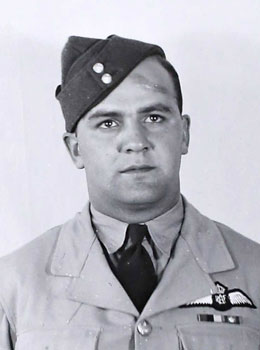During the evening of 6th November 1943 three crews from 431 Squadron undertook cross country training flights and were to be instructed to carry out three extra circuits and landings on their return to Tholthorpe airfield. One of the three landed at Topcliffe owing to a fuel shortage. The crew of DK264 returned to Tholthorpe and made the first landing and subsequent take off successfully. On the second approach to land and while just above the runway the aircraft stalled, as a result of the heavy landing at 20.37hrs the undercarriage collapsed and it came to rest badly damaged close to the intersection of Runway 28 amd 34. Other aircraft that were in the air at the time were given orders to divert to Linton on Ouse to land. By 23.30hrs the Station Engineering section began to move the aircraft and believed it to be a write-off.
The date is given as 6th November 1943 in the Tholthorpe Flying Control log and as this is written in chronological order this must be correct. The entry in William Chorley's 1943 Bomber Command Losses book has this recorded as being on the 7th November 1943 which must be wrong.
Pilot - F/Sgt Gordon Francis Edwards RCAF (R/10616).
Crew - Names unknown.

Gordon Edwards was born on 8th October 1919 in Carr, Ontario, Canada and was a son of Ross and Jessie Matilda Edwards. He lived in Parry Sound for twelve years before the family moved to South River, attending junior school in South River. After leaving school he worked as a licensed guide in the Algonquin Provincial Park between 1936 and 1939 (some, including myself, would say this was probably one of the most idyllic jobs). On the outbreak of war he enlisted for RCAF service on 21st September 1939 in Toronto and after basic ground training became a member of motorboat crew, serving on RCAF rescue boats until March 1942. In March 1942 he re-mustered for aircrew service, had to drop rank and after receiving pilot training he was awarded his pilot's flying badge on 4th December 1942. He would leave Canada for the UK soon after but on arrival in the UK remained on the books of the personnel reception centre until May 1943 when he was posted to train at 14 (P)AFU. He was then posted to 23 OTU on 22nd June 1943. After 23 OTU he was then posted to 1664 HCU at Croft on 9th September 1943 and then to 431 Squadron on 9th October 1943. Throughout this latter part of his training he had struggled with night-flying and had stated that he had struggled with night-flying, particularly after converting to flying the Halifax type. He flew one operational flight with 431 Squadron, as a second pilot to F/Sgt Philip Davis' and his crew on the night of 22nd / 23rd November 1943 in Halifax LK905 to Berlin. Following the mishap at Tholthorpe on 7th November 1943 his night flying ability was checked, he passed the initial test but on the next solo night-flying basic circuits and landings excerise he damaged another Halifax on landing (I have yet locate the details of this but it should be recorded as a seperate incident on this website). It was thought that he struggled flying on instruments at night so was then taken off front line operational Bomber Command flying with a recommendation that he be posted to fly a lighter aircraft and during day operations. His day flying ability was not questioned and as there was little need for him to be in the UK it was recommended that he be repatriated to Canada and to be employed as a staff pilot at a training unit in Canada. He was posted from 431 Squadron on 3rd January 1944 and was repatriated in February 1944. He may then have become a staff pilot with No.1 Bombing and Gunnery School at Jarvis, Ontario. He received a commission on 27th July 1944 to the rank of P/O. On 14th November 1944 he was on a period of leave and had returned home. While on a hunting and shooting trip in the Port Loring area he was sadly involved in a shooting accident which resulted in his death. He was engaged to be married at the time of his death and he must have been in the rank of Acting F/O. He is buried South River Cemetery, Ontario, Canada.